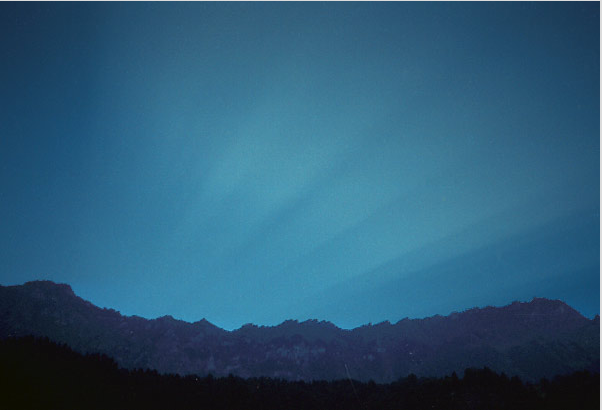Twilight rays
Twilight Rays: A Stunning Atmospheric Phenomenon
Twilight rays, also known as crepuscular rays, are a captivating atmospheric phenomenon that occurs during twilight hours. The term "crepuscular" is derived from the Latin word "crepusculum," meaning twilight. While the term technically refers to sunbeams specifically during twilight, it is commonly used to describe sunbeams at any time of the day. These rays create a mesmerizing display of light and shadow, adding a touch of magic to the sky.
True twilight rays become visible after the sun has set and is positioned up to 4º below the horizon. They are formed when large cloud banks or mountains, still illuminated by sunlight, cast shadows across the sky. These shadows can extend for tens or even several hundred miles, creating long, arching beams of light. The rays can even appear on the opposite side of the sky, forming what is known as anti-crepuscular rays. Keep a keen eye out for these ethereal rays, as they often exhibit a beautiful bluish-green hue against the backdrop of the twilit sky's glowing purple hues.
Twilight rays are a result of the interplay between light and shadow in the atmosphere. As sunlight passes through gaps in clouds or around the edges of mountains, it interacts with dust particles, water droplets, and other atmospheric constituents. This interaction scatters the sunlight, causing some areas to appear brighter while others remain in shadow. The contrast between these bright and dark regions gives rise to the distinct beams of light that we observe as twilight rays.
The phenomenon of twilight rays is not limited to any particular geographical location; it can be witnessed across the globe. However, certain conditions are more conducive to their formation. Twilight rays are most commonly observed in areas with a high frequency of cloud cover, such as coastal regions or mountainous areas where clouds often form or linger. These regions provide ample opportunities for large cloud banks or mountains to cast long shadows across the sky, creating a perfect canvas for the rays to manifest.
To fully appreciate and capture the beauty of twilight rays, it is important to be in a location with an unobstructed view of the horizon. Being positioned at an elevated vantage point, such as a hilltop or a rooftop, can enhance the visual spectacle by allowing a wider expanse of the sky to be visible. Additionally, the presence of a dramatic backdrop, such as a colorful sunset or a vibrant twilight sky, further enhances the overall experience of witnessing these enchanting rays.
Photographing twilight rays can be a rewarding endeavor, as they provide an opportunity to capture nature's artistry. To capture the essence of these ethereal beams, it is advisable to use a wide-angle lens to encompass the vastness of the sky. Experimenting with different exposure settings can help achieve the desired effect, whether it be emphasizing the contrast between light and shadow or capturing the subtle color variations within the rays themselves.
In addition to their aesthetic appeal, twilight rays also serve as a reminder of the dynamic nature of our atmosphere. They showcase the interplay between light and shadow, highlighting the intricate processes that occur within our atmosphere. By studying and understanding these phenomena, scientists gain valuable insights into the behavior of light in different atmospheric conditions, contributing to our broader understanding of the world around us.
In conclusion, twilight rays are a breathtaking atmospheric phenomenon that adds a touch of magic to the twilight hours. These captivating beams of light and shadow are formed by large cloud banks or mountains casting long shadows across the sky. Their bluish-green hue against the backdrop of the twilit sky creates a truly mesmerizing sight. By appreciating and studying these phenomena, we gain a deeper understanding of the intricate workings of our atmosphere and the beauty that nature has to offer. So next time you find yourself beneath a twilit sky, take a moment to look up and witness the wonder of twilight rays.

Twilight rays Locarno, Switzerland. Taken by Tony Williams of Liverpool Astronomical Society August 1998. ©Tony Williams, reproduced with permission.
Crepuscular derives from the Latin "crepusculum" for twilight. Strictly speaking, only twilight rays should be called crepuscular but in practice the term is used for sunbeams at any time of day. True twilight rays are visible after the sun has set and is up to 4º below the horizon. They are formed from shadows cast by large cloud banks or mountains still in sunlight and up to tens or even several hundred miles away. The rays arch high across the sky and sometimes even form anti-crepuscular rays. Look carefully for them, they are bluish-green against the glowing purple of the twilit sky.
Note: this article has been automatically converted from the old site and may not appear as intended. You can find the original article here.
Reference Atmospheric Optics
If you use any of the definitions, information, or data presented on Atmospheric Optics, please copy the link or reference below to properly credit us as the reference source. Thank you!
-
<a href="https://atoptics.co.uk/blog/twilight-rays/">Twilight rays</a>
-
"Twilight rays". Atmospheric Optics. Accessed on November 26, 2024. https://atoptics.co.uk/blog/twilight-rays/.
-
"Twilight rays". Atmospheric Optics, https://atoptics.co.uk/blog/twilight-rays/. Accessed 26 November, 2024
-
Twilight rays. Atmospheric Optics. Retrieved from https://atoptics.co.uk/blog/twilight-rays/.